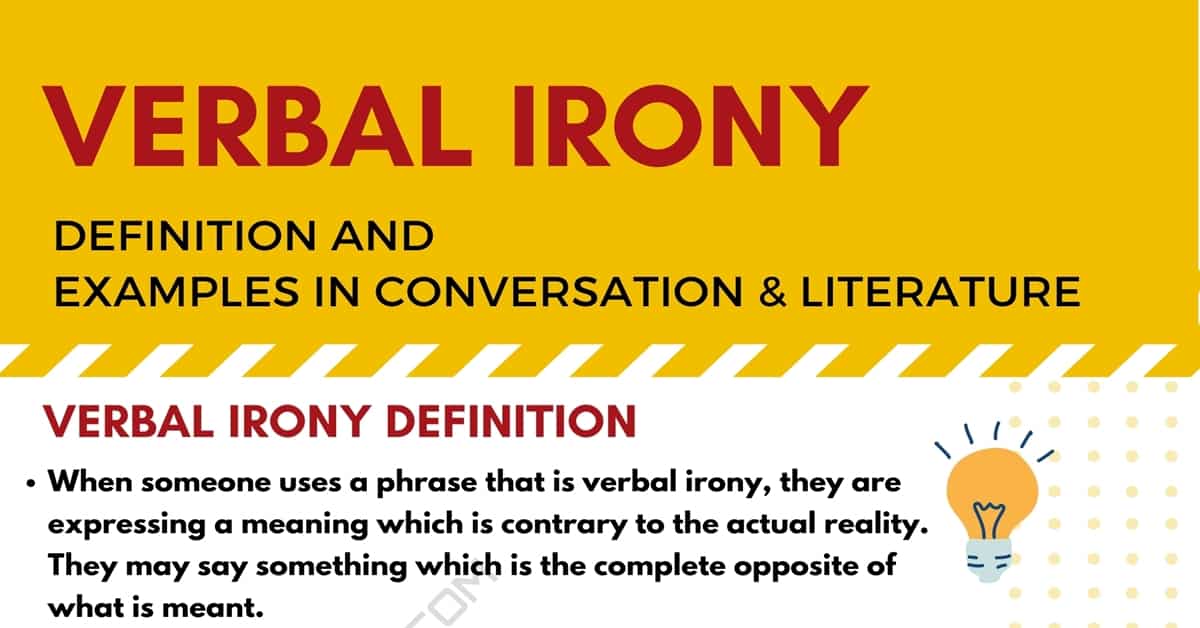Using literary devices in your writing helps make your story deeper and pull the reader in for an engaging experience.
Irony is an excellent device because it points your reader in one direction, then pulls the rug out from beneath them with an unexpected outcome.
Read on to learn more about irony and writing tips.
What Is Irony?
Irony comes from the Greek word “eironeia,” which means “feigned ignorance.”
This root word and definition help you see how writers use irony to create humor and suspense, crafting a story in one direction and then stumbling upon surprising results.
If you’re struggling with things to write about, consider how irony could mix up your content for an unexpected outcome.
Also Known As:
- Wit
- Satire
- Cynicism
Simple Definition: How To Explain Irony to a Child
The simplest way to explain irony is to say it’s using words to convey the opposite of what’s said
Someone called into work on the weekend might employ verbal irony to say, “Just how I wanted to spend my Saturday!”
Why Is Irony Used?
Writers use irony to make their stories more complex.
Instead of explaining things that happen in a linear, matter-of-fact manner, irony creates suspense.
The writer leads the reader towards an apparent, intended resolution.
The irony is in the opposite outcome, establishing a dramatic twist for the reader.
Types of Irony
Just as there are many content types when it comes to blogging, there are different types of irony.
You can use the four types of irony differently, depending on the story you’re telling.
Learn what each means so you can effectively use it in your writing.
- Dramatic Irony: Dramatic irony occurs when the audience or reader knows something in advance, but that information isn’t known to the characters.
- Situational Irony: Situational irony refers to experiencing the opposite outcome from what you or your audience expected.
- Socratic Irony: Socratic irony refers to someone who acts ignorant to inspire others to speak up. The original person then challenges the others’ claims to prove their point.
- Verbal Irony: Verbal irony happens when a person makes one statement but means the opposite.
How Do You Identify Irony?
You can identify irony by understanding the basic situation.
The writer implies what’s supposed to happen, and your mind fills in the rest.
When the opposite happens, you’ll realize they used irony.
You can also identify verbal irony when dialogue doesn’t match the situation.
Identify Socratic irony when the person “plays dumb” to get interaction.
How Do You Use Irony in a Sentence?
Irony is a noun, so you’ll use it in a sentence like, “The irony was that I wanted to scare you, but you ended up scaring me.”
As you consider how to write a blog post, you want to ensure you use irony properly.
What Is the Most Popular Example of Irony?
The most popular example of irony is Alanis Morissette’s 1996 hit single “Ironic.”
The lyrics include situations like a man waiting his whole life to fly, then dying in a plane crash.
The critical reaction to the song explains how many lines aren’t ironic at all, but it’s still a famous example.
Other Famous Examples of Irony
Irony is a broad category that you most likely see in action every day.
The following examples help you understand how it occurs in typical situations.
Public Complaints
People have social media at their disposal, so you often see them sound off with complaints.
Some of the best ironies are when users tweets about how frustrated they are with Twitter.
Unexpected Events
The police department helps keep a community safe.
Therefore, when someone robs the police station, this twist is ironic.
A cop having unpaid parking tickets is also an example of irony.
Human Nature
If a pilot has a fear of heights, that’s an example of irony.
An English teacher misspelling words is also ironic.
Other Modern Examples of Irony
While the previous examples are broad so you can understand how irony applies to your life, the following are more specific.
Examples of Irony for Kids
Kids love irony because it’s unexpected.
These examples help kids understand how irony works in different occurrences.
- Situational irony: A funny example of situational irony is when a kid runs from his friend who’s about to throw a water balloon. The kid doesn’t look where they’re going, so they run straight into the pool. They get wetter from the pool than if they’d let the water balloon hit them.
- Verbal irony: If you walk outside to feel the weather, you might say, “Just another beautiful day!” even if it’s pouring rain.
- Dramatic irony: Hannah Montana is an excellent example of dramatic irony because she dresses like a normal kid, then pretends to have a separate life as a pop star. The viewers know she’s one person, but the characters think they’re two individual people.
Examples of Irony in Speech
Irony in speech is something many people say and hear every day without realizing it.
Read on to see if you’ve recently engaged in verbal irony.
- In groups: If you want people in a meeting or class to chime in with questions, but they’re silent, you might say, “Don’t all talk at once!”
- At work: When someone is rude to you, you might say, “Have a nice day,” even though you wish them the opposite.
- With your kids: If your child never cleans their room, you might walk into the mess and exclaim, “It looks great in here!”
Examples of Irony in Literature and Writing
Writers love using irony in literature and writing because it creates suspense for the reader.
The reader thinks one thing will happen, but the twist ending shows that the opposite is true.
- The Gift of the Magi: This story embodies irony as a young couple sells their most prized possessions to buy gifts for each other. The irony is that the gifts are pointless, as each person sold the related item to afford the gift.
- The Wizard of Oz: This children’s book showcases irony that isn’t revealed until the end. The characters spend the whole story searching for attributes like courage and brains just to realize they already possess those features.
- The Necklace: This short story by Guy de Maupassant features a woman who borrows her friend’s diamond necklace but loses it. She works herself to the bone to earn enough money to replace the jewelry, only to learn the original necklace was fake.
Notable Writers Who Used Irony
There are many types of writers, and some use irony to heighten their stories.
This literary device can add suspense and tension to the book.
It can help the reader feel involved, especially if they know something the characters don’t.
O. Henry
As previously mentioned, O. Henry uses lots of irony in “The Gift of the Magi.”
The entire premise is ironic, and he amplifies that humor with further irony.
For example, when the wife realizes she doesn’t have enough money for gifts, she cries and feels sorry for herself, displaying it as a tragedy.
The ending is also ironic, as the characters aren’t upset.
Kate Chopin
In her short story, “The Story of an Hour,” Kate Chopin uses situational and dramatic irony to increase tension until it’s almost unbearable.
Mrs. Mallard hears that her husband died and realizes that she’s pleased.
She felt smothered and started imagining how her life would improve.
However, her husband didn’t die, shocking her and damaging her already-fragile heart.
William Shakespeare
In Romeo and Juliet, William Shakespeare uses dramatic irony to keep the reader on the edge of their seat.
The young couple is so in love they want to die together.
Romeo thinks Juliet died, so he drinks poison to join her.
The audience knows what Romeo doesn’t—that Juliet isn’t dead.
They feel suspense watching Romeo die, which amplifies the story’s heartbreak.
What Is the Opposite of Irony?
Sarcasm is the opposite of irony. Many people think they’re related, but there are key differences.
Irony refers to situations, while sarcasm is a form of expression.
Irony vs. Sarcasm
Irony communicates the opposite result compared to what you expect.
The audience is usually in on the joke.
They know what to expect and why the result isn’t right.
Sarcasm is harsher, usually directed at a person as a way to humorously criticize them.
Some people use sarcasm in a way that goes over the intended recipient’s head and comes off mean-spirited.
Other Related Literary Devices To Know
Irony is an excellent literary device to use in your writing.
Check out these related devices that will liven up your content.
- Metonymy: Metonymy is a literary device that substitutes a name for something with an attribute, like calling a business executive a “suit” or referring to the movie industry as “Hollywood.”
- Coincidence: Coincidence refers to events that happen and work well together but aren’t purposeful or scripted.
If you travel to New York from a small town and run into your friend there, it’s a coincidence you’re both in the same city. - Synecdoche: Synecdoche is a figure of speech that uses part of an item to refer to the entire entity. For example, you can say, “Let me grab my wheels,” meaning your car.
- Metaphor: Metaphor is a figure of speech that uses a phrase to apply to an object it normally wouldn’t describe. For example, an outcast described as a black sheep is a metaphor.
- Symbolism: Symbolism is a literary device that uses one object to represent another.
For example, a wedding ring represents marriage and commitment but is a random item endowed with this meaning.
Writing Tools To Help You Out
Writing can take a lot of work, especially if you want to use the literary devices explained above.
Streamline your content creation process by taking advantage of writing tools on the market.
- Writing Helpers: It’s tough to brainstorm ideas and keep your blog current, so consider using writing helpers. These tools simplify your work by generating post topics and creating articles and videos that draw in an audience.
- AI Writing Software: Instead of making time to write blog posts and social media captions yourself, consider using software that uses AI to write. Enter a few keywords, and you’ll get a complete piece to use on your site.
- Grammar Checkers: You might be a great writer, but typos and errors can prevent your audience from understanding your point. Use grammar checkers to polish your writing before you publish it.
- Content Creators: From topic ideas to keywords that draw in traffic, a content creator will help you go from a blank page to an engaging blog with a devoted audience.
Frequently Asked Questions
If you need more information about irony and literary devices, check out the answers to these frequently asked questions.
Is irony the same thing as a figure of speech?
No, irony isn’t the same as a figure of speech.
A figure of speech is a phrase that’s used in a new way, not aligned with its literal definition.
Irony conveys the opposite of the intended meaning.
What is the opposite of sarcasm?
Sarcasm is a blunt, somewhat humorous way to criticize someone.
The funny aspect of the words can remove the sting intended and can also mean the person doesn’t understand the true point of the statement.
Therefore, the opposite is a compliment or flattery, which a speaker uses to make the recipient feel good about themselves.
Wrapping Up
Add irony to your writing to heighten the humor and twist the outcome.
Your reader will expect one thing but end up with something entirely different.
This device can help them feel like part of the story because they’re trying to solve the mystery, too.
It can also keep them on their toes and show them that they’ll never guess what comes next.
Read & Write : write for us
 Lifeyet News Lifeyet News
Lifeyet News Lifeyet News





